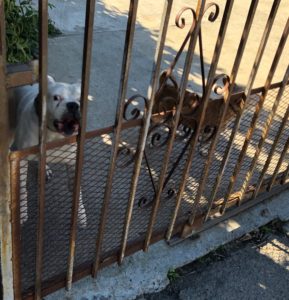Every dog is different, and every case deserves its own consultation. We must cater to the dog and the family, that’s what any good behavior consultant or board-certified professional trainer does.
That said, I want to list two of the early steps in many training plans. This is a generalization. It tends to fit a great number of cases, but this blog post is not intended to be a training plan. For a plan, contact us.
Expert prevention

A daily routine: These dogs bark at everyone, all day, while their owner occasionally yells at them to stop. A training program would start with structuring their day so they aren’t both out at the same time and when they are in the yard the owner is actively working with them to prevent barking and to form new habits.
The first thing we always want to do is make sure the behavior problems are not rooted in a physiological problem. Always consult with your veterinarian first.
The second step is one that a paramedic might call, “Stop the bleeding.” My mentor and founder of “I Said Sit!” School for Dogs would reference this step when he would say, “Stop your dog from becoming an expert at practicing the unwanted behavior.” If your dog is already an expert, at least stop him from rehearsing for his next episode.
List of common problems and where to start
Assuming you’ve visited your veterinarian to rule out a medical/physical cause to your dog’s behavior issues, let’s move on to the second step. Below are statements I hear every day, followed by a piece of “expert prevention” advice.
Issue: My dog barks at other dogs on leash but is fine when he gets to meet them.
Suggestion: Stop allowing your dog to meet those dogs on leash. You might be rewarding his barking and pulling, or you might be increasing his arousal and anxiety around the situation by putting him in a conflicting situation.
Issue: My dog growls sometimes when I try to get him off the couch.
Solution: Stop allowing your dog on the couch. Stop him from practicing the couch growling. You might need to forever ban him from the couch, or you might need to train him to only be in one area where you don’t bother him, and to move on his own when you ask him to move.
Issue: My dog walks fine leaving the house but pulls on the way home.
Suggestion: Perhaps your dog would rather be home than out on the walk. Resist the urge to get far away, thereby giving him a chance to practice pulling on the way home. Condition his confidence and desire to be outside, by training at a closer distance to home, and only reward loose leash behavior.
Issue: My dog is not food motivated.
Suggestion: Perhaps you’re feeding your dog too much or feeding her the highest value food or treats already, so there is no better quality to advance toward when needed for training. If your dog gets food and treats for free constantly, there is no motivation to work for it. Stop leaving a filled food bowl laying around. Or maybe your dog is over stimulated or nervous in training situations. I’ve trained countless dogs using rewards that aren’t food, but at the same time, if something eats, it can be trained.
Issue: My dog is too mouthy.
Suggestion: When your dog is in a mouthy mood, keep your hands away. Stop carrying your puppy. Use a leash to keep your puppy from practicing play attacks on your pants. If she redirects onto the leash, either put the dog away for the time being or temporarily switch to a stainless-steel tether that won’t reward your puppy’s leash chewing.
Issue: My dog pulls on leash.
Suggestion: Stop allowing your dog to get anywhere by pulling.
Issue: My dog loves the crate but only when I leave the door open.
Suggestion: Start closing the door. Ignore the barking. Keep using positive reinforcement to make the crate a happy place. Feed meals in the crate. When it isn’t a time for the puppy to be crated, don’t perpetuate over-bondedness by having your puppy on the human bed or couch, or carried in your arms.
Issue: My dog is chewing the furniture
Suggestion: Do not give your dog access to chewing on the furniture. Keep her supervised while you are working on a training plan.
Issue: My dog barks at everything she hears and sees when at home
Suggestion: As with all these bullet points, you’ll need more information than to “stop” allowing something. Chronic barking is one of my favorite puzzles to solve, as there are many moving parts and I enjoy cracking to code on what to address first. However, one great place to start, is to do what I call, “teaching your dog to meditate.” In other words, train your dog to settle calmly in a crate or small pen, in a quiet environment. When a dog doesn’t have access to a wider space range where he’ll get all riled up, it is easier to get him to change his default behavior to something easier to live with.
Issue: My dog only listens to me when I have food.
Suggestion: Stop using food as the reward so often and begin to use other real-life rewards as reinforcers for desirable behavior. For example, require a wait, or sit, or “come” before receiving anything she likes, including petting, praise, walks, couch time, etc. When you do use food, get it out of the picture, out of your hand especially, until after the dog performs the request.
Issue: My dog keeps having potty accidents in the house.
Suggestion: Don’t allow your dog to have access to the house unless he just pottied outside, and you are directly supervising. On leash. Together. After twenty or thirty minutes, crate your dog again. Help him learn how to hold it while inside.
Hopefully you get the pattern here. All the suggestions involve making changes to add more structure to your dog’s life. None of the above suggestions, however, are training plans. They are just common first steps (after consulting a veterinarian). In fact, if you’ve already been given a training plan (to work on mouthing, jumping, barking, destructive chewing, pulling, growling, etc.) and you skipped the above management step, there is a good likelihood you are wasting your time and money or at the very least, making the training plan a lot longer than necessary.
If any of the above problematic behaviors reminds you of your life with your dog, contact a dog behavior consultant or board-certified professional dog trainer. We are here for you!



